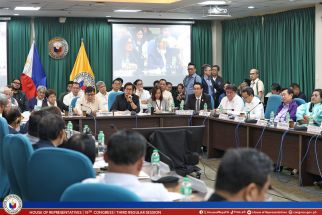P10 billion more for ‘Pablo’ rehab
MANILA, Philippines - The government is ready to spend at least P8 billion to P10 billion more for relief and rehabilitation efforts in storm-ravaged areas in Mindanao, as search and rescue operations are set to continue even during Christmas and New Year’s Day.
Budget Secretary Florencio Abad said the cost for the relief and rehabilitation efforts could go over P10 billion, given the extent of damage left by typhoon “Pablo.”
The National Disaster Risk Reduction and Management Council (NDRRMC) had estimated the damage to agriculture and infrastructure at P34.3 billion.
Abad said the calamity is an opportunity for the government to spend more through relief and rehabilitation operations. He said the administration has so far spent at least P4 billion, and that reconstruction would take more time because the priority at this time is rescue and relief.
The P8 billion to P10 billion would be taken from the government’s calamity and quick response funds.
“The P8 to P10 billion is what is available and is originally the projected requirement, but you know the numbers can change as we go along,” he said.
The budget chief said there has been various fund requests from affected regions, particularly for the replanting of various crops including corn, which can mature in 45 to 90 days.
NDRRMC executive director Benito Ramos said the government has not set a deadline for the search and rescue operations, so security forces would continue efforts to find more survivors.
Ramos said they are still optimistic to find more survivors, although it has been three weeks since Pablo battered the southern part of Mindanao.
He said rescue teams – which include Navy, Coast Guard and police personnel and employees of fishing firms – do not mind working even during the holidays.
“Many of them are soldiers and they are used to it. Everyone is ready to perform their duty,” he said.
When asked when the rescue teams would halt the operations, Ramos said they would take their cue from Armed Forces Eastern Mindanao Command chief Lt. Gen. Jorge Segovia and other officials in the field.
“The number of fatalities may still increase but we do not assume immediately that the missing persons have died,” he said.
As of yesterday, the death toll from Pablo stood at 1,067 while 834 remained missing.
AFP chief visits rescue teams
Armed Forces chief Gen. Jessie Dellosa flew to Davao City yesterday to visit the troops undertaking relief and humanitarian operations in the area.
Dellosa went to the headquarters of the 67th Battalion to assess the rescue and relief operations. He was also scheduled to visit the 66th Battalion based in Banganga, Compostela Valley.
The military has so far raised P19 million in contributions, donations, and savings generated from the cancellation of Christmas parties and the toned down AFP anniversary celebration.
“More than the cash donations, a simple gesture of physical support will encourage and inspire the typhoon victims to slowly stand up and look forward to a brighter tomorrow,” Dellosa said in a statement.
Meanwhile, an official of the Catholic Bishops’ Conference of the Philippines (CBCP) appealed yesterday for more assistance, particularly housing materials and food, for the typhoon victims.
Fr. Edu Gariguez, executive secretary of the CBCP’s National Secretariat for Social Action (NASSA), said the villagers need roof as soon as possible.
Gariguez also sent his appeal for aid to their international partners.
The Archdiocese of Lipa in Batangas will hold a second collection in all churches during masses on Christmas day.
“The second collection will be given entirely to Pablo victims. All priests-celebrants of Christmas Masses are requested to encourage the faithful to be very generous in sharing the joys of Christmas with the victims,” Lipa Archbishop Ramon Arguelles said.
Gariguez reminded the public that food for the traditional noche buena need not be extravagant because Christmas is not about food, but about sharing.
He said instead of worrying about food, the faithful should think about the poor and the thousands of typhoon victims who could not even afford a simple meal.
“We should share our blessings to the needy. It’s saddening that while we are feasting there are people who have nothing to eat,” he said.
Tent classrooms in typhoon-hit areas
Education Secretary Armin Luistro said over the weekend that tent classrooms would be put up in disaster-hit areas, particularly in Compostela Valley and Davao Oriental, in time for the resumption of classes on Jan. 3.
Luistro told The STAR during a visit in Davao City that the tents would serve as classrooms for students whose schools have been badly damaged by the typhoon.
“In that way, classes will continue even if we will use tents first, as it takes time to build new or rehabilitate damaged school buildings,” he said, adding he was in town to oversee the establishment of the tent classrooms.
This developed even as US Ambassador to the Philippines Harry Thomas Jr. said his government has vowed to continue helping the typhoon victims.
Thomas said this is the US’s way of showing gratitude to the Filipinos for helping the Americans when superstorm Sandy battered the east coast last October.
He said the US would also continue helping in search and rescue efforts for the more than 300 fishermen still missing.
Team Albay takes over operation of Cateel hospital
An emergency response group from Albay has temporarily taken over the operation of the Cateel Emergency Hospital in Davao Oriental to speed up medical relief for victims of typhoon "Pablo."
The hospital was almost deserted after it sustained heavy damaged from typhoon. It services five towns including Bangaga and Boston, two of the hard-hit areas.
The 72-man Team Albay was among the first groups to rush to Mindanao three days after the devastation.
Albay Gov. Joey Salceda dispatched the team to Davao Oriental and Compostela Valley to immediately help in relief operations.
Headed by Dr. Cedric Daep, Albay Provincial Safety and Emergency Management Office chief, the team first pitched camp in the flattened town of Boston, where its Water and Sanitation unit immediately provided 17,500 litters of potable drinking water to victims in the first two days.
Team Albay's medical group, headed by Dr. Eric Raborar, set up base at the neighboring town of Cateel, with its mobile medical units serving villagers in isolated areas without evacuation centers.
From there, the team was allowed to take over the Cateel Emergency Hospital, to maximize health services, and serve as a staging point of other medical missions in nearby areas. Edith Regalado, Helen Flores, Alexis Romero
- Latest
- Trending

































